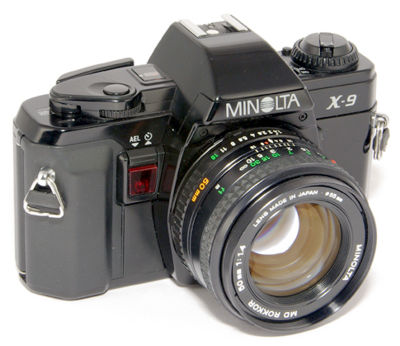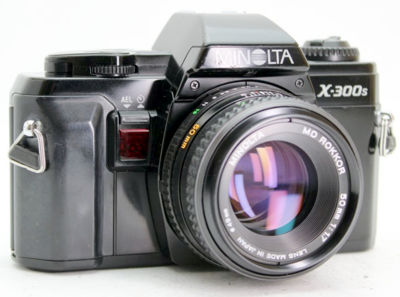

X-9
The X-9 was Minolta's last, new SLR. It used a body that was similar to the popular X-370 camera, but there were several stylish changes. For example, the pentaprism has a sleeker, curved top instead on the older angled top, and the hand grip is smaller and sports a new, smooth covering. These changes make the camera much more attractive than the X-370.
But while Minolta may have smoothed some corners on the X-9, it did not cut any. For example, the X-9 has a DOF preview button, unlike the X-370. The DOF button is now square, but it's in the same place. The viewfinder displays the automatically selected shutter speed in auto-exposure mode, and both the recommended shutter speed as well as the manually set shutter speed in manual-exposure mode (one blinks and the other doesn't). In either mode, the viewfinder also has the manually set aperture -- unlike the X-370. The hot-contact, "touch-switch" shutter release button of the X-370 is gone, but the camera retains the safe-load signal for correct film loading. It has an Auto-exposure (AE) lock and Depth-of-field button, and it accepts the Winder G as well as the Motor Drive 1. Perhaps the most unusual feature is the focusing screen -- it has a diagonal, split-image rangefinder with a microprism collar inside the fresnel screen. The screen is removeable, but it is not interchangeable with any other Minolta screens, unfortunately.

It takes a little getting used to if you are experienced with the horizontal type split, but it's actually an improvement. This is the only Minolta camera that used this focusing screen. It has other features as well, such as a film window, on-off switch and a self-timer -- just like an X-370n. It was only available in an all black body.
There were actually two versions of the X-9.

Only available in black.

Sold in the European market. Despite the name, it in not an X-300, and has much more in
common with the X-9 -- with just a couple of differences. First, the X-300s lacks the diagonal split-image
screen of the X-9 --.it has the standard horizontally-oriented screen. Secondly, the X-300s lacks a DOF button.
One important quality control issue pertains to the capacitor in the X-9 (and the X-570 and X-300 cameras, as well). They tend to "leak", and in the process, malfunction. You can usually spot a bad capacitor easily. Turn the camera on, using good batteries. Touching the shutter release button will turn on the LED meter for a second, but then it goes out. Some contend that the problem stems from the move to China and cheaper capacitors. There may be some truth to this as the earliest X-700 cameras have fewer capacitor problems. Others contend that the capacitors leak with time, use and humidy. In any case, it's an expensive repair -- unless you do it yourself -- and one reason some people avoid the last models that Minolta made. There are instructions on how to DIY replace the capacitors in the MINMAN MAIN MENU.
The X-9 was the last, new manual-focusing 35mm SLR camera that Minolta would make. It is a very competent camera -- designed for automatic exposure or manual control. Production stopped before the final production of the X-700, so it is not Minolta's last manual-focusing 35mm SLR off the assembly line, but the X-9 has a definite place in Minolta's history.
Because of the name, the X-9 is often confused with the XG-9, but they are very different. For a comparative look at the major features of the X-9 versus the XG-9 (a very nice SLR in its own right), check out MINMAN's SLR table -- the world's most complete!
RETURN TO THE MANUAL MINOLTA HOME PAGE
We didin't want to do this, but since other websites have been stealing our stuff, we have no alternative but
to state:
COPYRIGHT@1995-20253 by Joe McGloin.
All Rights Reserved. The material on this website is protected by US Federal copyright laws. It cannot be copied
or used in any manner without specific approval from the owner.
The material on this website is protected by US Federal copyright laws. It cannot be copied or used in any manner without specific approval from the owner.